Key takeaways:
- Curriculum effectiveness in religious education is measured by student engagement, personal connections to the material, and the development of critical thinking and empathy.
- Evaluating curriculum requires a focus on clarity, inclusivity, and opportunities for active participation to ensure all students feel represented and can engage in practical applications of their learning.
- Continuous feedback from students is crucial for understanding their needs and improving teaching methods, highlighting the importance of creating safe spaces for dialogue.
- Incorporating diverse assessment methods and interactive activities enhances student learning and allows them to express their understanding in various ways.
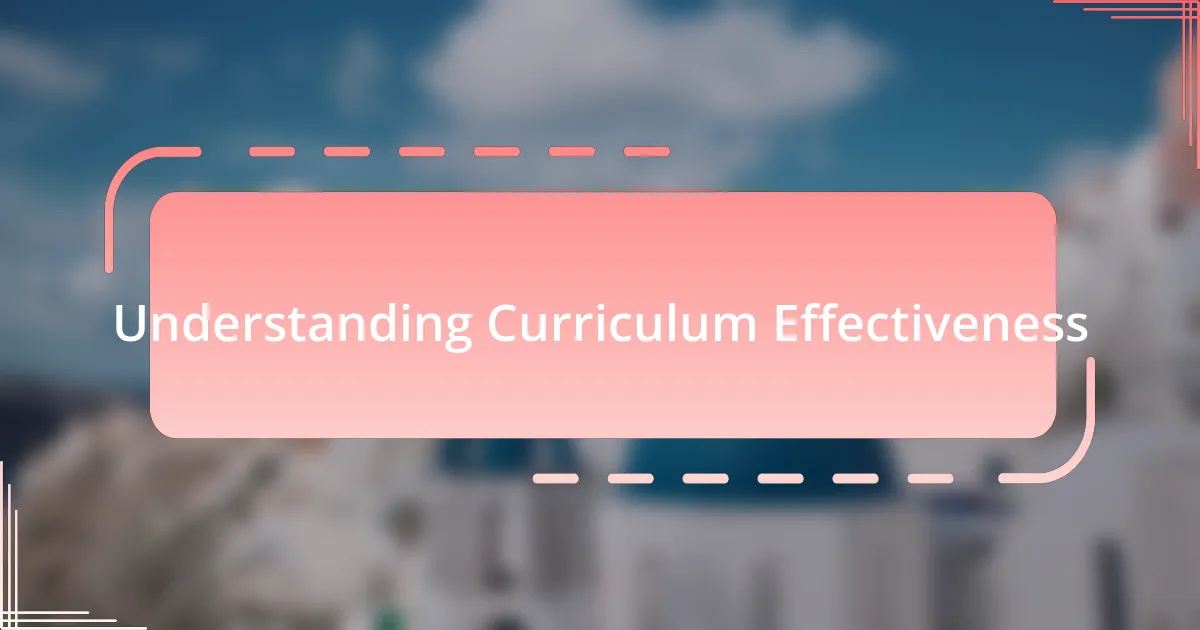
Understanding Curriculum Effectiveness
Understanding curriculum effectiveness in religious education goes beyond just assessing the content delivered. For me, it’s about witnessing how students internalize and relate to their teachings. I once observed a class where students were not just reciting facts but discussing their personal interpretations of religious texts. It was fascinating to see how deeply they connected the material to their own lives.
When I think about what makes a curriculum truly effective, I often ask myself how it encourages critical thinking and personal growth. In one of my experiences, a group project allowed students to explore their beliefs and those of others, fostering a sense of empathy that transcended the classroom. This approach made me realize that effectiveness isn’t merely in knowledge retention but how it transforms perspectives and nurtures a respectful dialogue about faith.
Ultimately, I believe evaluating curriculum effectiveness requires us to look at the long-term effects on students’ lives. Have they developed a deeper understanding and appreciation for their own faith and others? Seeing a former student passionately engage in community service inspired by their religious studies truly affirmed for me the lasting impact that a well-designed curriculum can have. It’s moments like these that confirm the importance of ongoing assessment and adaptation in our educational practices.

Importance of Religious Education
Religious education holds a profound importance in shaping not just knowledge, but also character. I recall a moment during a discussion about moral dilemmas where a student shared how their religious teachings guided their decision-making. It struck me how a simple lesson could ripple out into real-life applications, highlighting the curriculum’s role in building ethical frameworks.
Beyond fostering moral principles, religious education serves as a bridge for interfaith understanding. I remember facilitating a panel where students from various backgrounds shared their traditions and beliefs. The respect and curiosity that emerged from that dialogue were truly inspiring. It made me wonder—how often do we create spaces for students to learn from one another in such a meaningful way? Engaging in these conversations can cultivate a sense of community and shared humanity.
Moreover, religious education encourages students to reflect on their own beliefs, promoting self-awareness and personal growth. I have seen students grapple with big questions about faith, identity, and purpose, often leading to transformative insights. It’s fascinating to consider how these explorations might shape a young person’s journey through life. Are we equipping them with the tools to navigate their spiritual paths? These reflections remind me that the importance of religious education is not just in what we teach, but in how we inspire our students to think deeply and act positively in the world.

Key Evaluation Criteria
When evaluating curriculum effectiveness, I focus on clarity and alignment with educational goals. One experience that stands out to me involved revisiting a unit on sacred texts, where we examined not just content but the clarity of the lessons. I realized that the students’ engagement was directly tied to how well the teachings connected with their lives. Isn’t it crucial for students to see the relevance of their learning?
Another key criterion is the diversity of perspectives included in the materials. I once facilitated a class that showcased various interpretations of a key religious concept. Watching students connect different viewpoints deepened their understanding and highlighted the importance of inclusivity in religious education. It made me question, how can we ensure that every student feels represented in the curriculum?
Finally, I consider the opportunities for active participation. In one instance, we collaborated on a service project that was rooted in religious teachings. This hands-on approach not only reinforced the lessons but also fostered community bonds. Have we thought enough about providing students with practical applications of what they learn, allowing them to live out their beliefs?
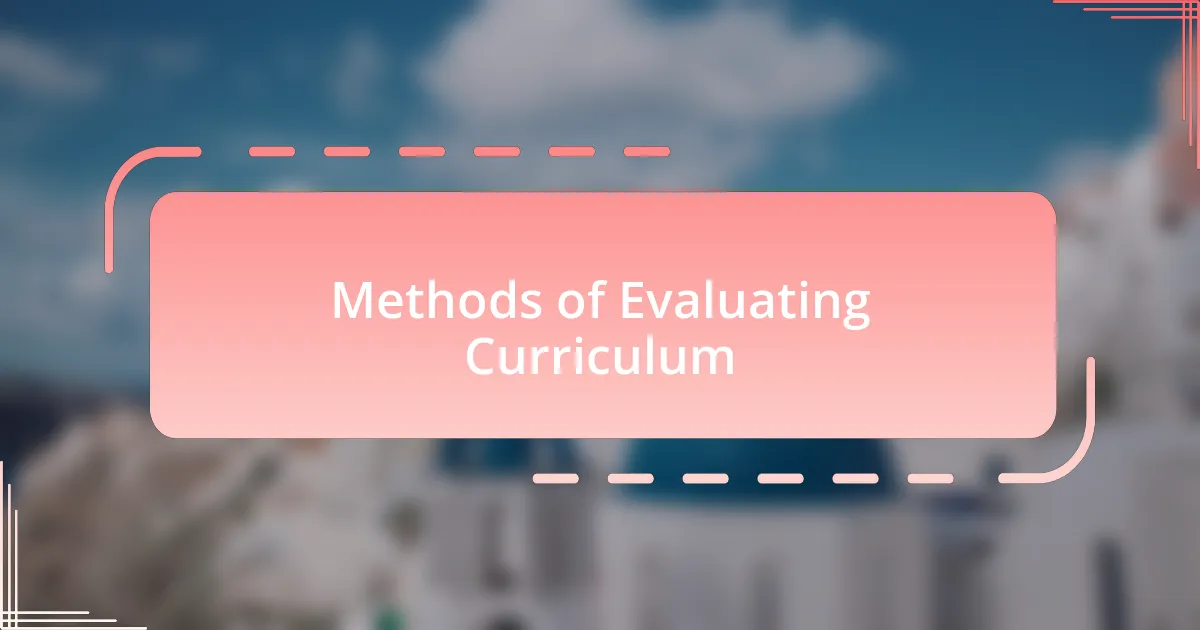
Methods of Evaluating Curriculum
Evaluating curriculum effectiveness involves several methods, each tailored to fit the unique needs of students and the subject matter. One method I often employ is collecting student feedback through surveys and focus groups. During a recent curriculum review, I asked students what they found most engaging in our lessons on morality. Their responses not only affirmed my assumptions but also prompted me to rethink how certain topics might resonate differently across age groups. Have you ever realized how valuable student input can be in shaping a more effective learning environment?
Another method is classroom observation, where I take a step back and look at the dynamics during lessons. I vividly remember watching a class debate on ethical dilemmas rooted in different religious texts. The passion students displayed made it clear that they were not just learning but actively connecting with the material. Observing how they engaged with each other helped me refine the curriculum to foster deeper discussions. How often do we miss these moments that highlight the curriculum’s impact?
Lastly, analyzing assessment outcomes is crucial in understanding curriculum effectiveness. I recall a specific instance where test scores on topics related to prayer and reflection were notably lower than expected. This prompted me to dig deeper into the teaching methods and materials used. Was I providing enough context for these important spiritual practices? It made me realize the need to adapt and provide richer resources, helping students better grasp these fundamental ideas. What can we learn from our assessments to improve our teaching strategies?
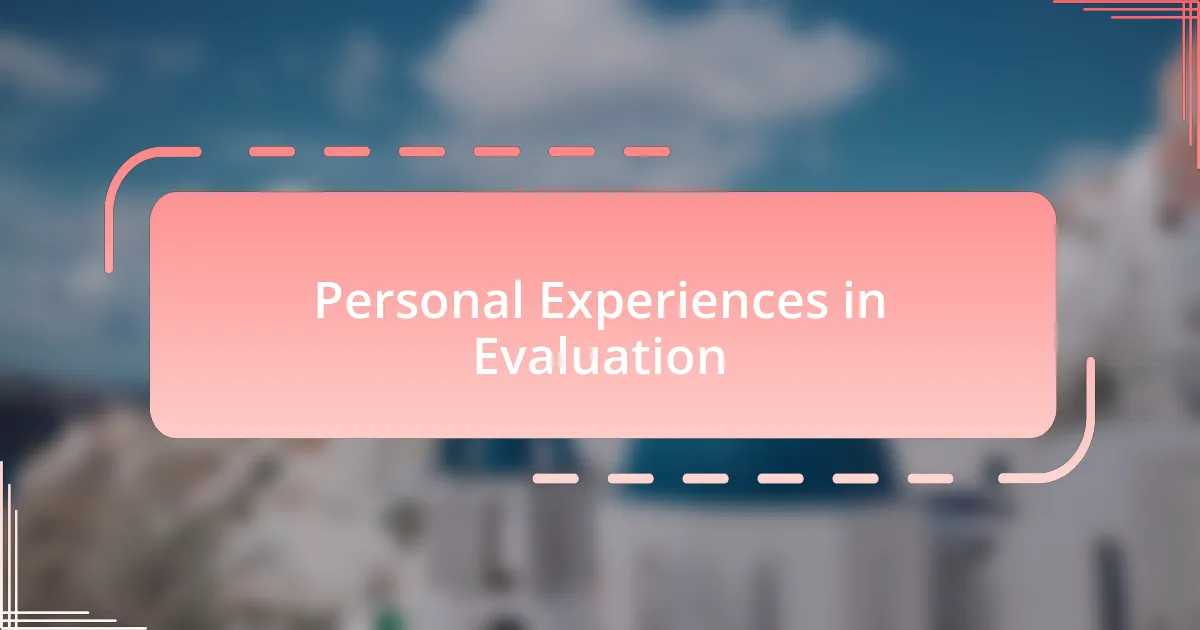
Personal Experiences in Evaluation
Evaluating curriculum effectiveness is as much about personal reflection as it is about methodical approaches. I remember a time when I was questioning the relevance of historical teachings in our religious studies. During a reflective session, I realized that my own connection to the material had faded over the years. This prompted me to re-examine how I presented the historical context of religious events, ensuring that I was not only conveying information but also sharing the emotional weight those stories carried. Have we ever stopped to think about how our own enthusiasm—or lack thereof—can shape students’ interest?
Another memorable moment came when I organized an informal discussion with colleagues about teaching methods. I found that just sharing our experiences helped us uncover different perspectives on our curriculum’s depth and breadth. One colleague shared a heartfelt story about a student who found solace in a particular lesson on compassion, which reminded me of the profound impact our teachings can have outside the classroom. How often do we forget that our curriculum is not just a collection of facts but a pathway to personal growth and understanding?
I once examined the hesitance some of my students showed during lessons on controversial topics, such as the intersection of faith and science. It struck me that the anxiety they expressed reflected broader societal conversations happening outside our classroom. Witnessing their struggles ignited a desire within me to create a safe space for discussion. This experience taught me that evaluation isn’t merely about metrics; it’s about tuning into the voices of students and adapting our approach accordingly. Can we ever truly understand our effectiveness without listening to those we teach?
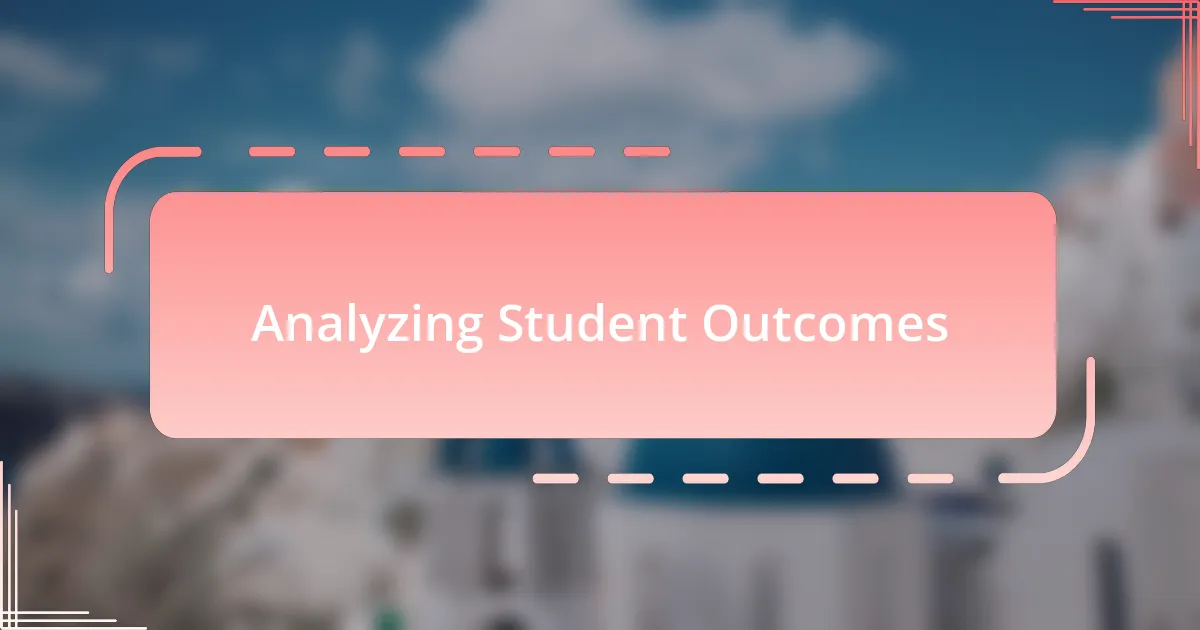
Analyzing Student Outcomes
When I began analyzing student outcomes, I noticed a clear pattern: engagement often dropped after lessons on more complex theological concepts. I remember one student in particular, who struggled to relate to our discussions on abstract interpretations of faith. Engaging in individual conversations revealed that he craved relatable examples to bridge the gap between theory and his everyday experiences. This struck me—how well do we cater to diverse learning needs?
I also took the time to review assessments and reflections submitted by students. One poignant comment from a quieter student stood out; she expressed how a lesson on interfaith dialogue opened her eyes to perspectives she had never considered. It made me realize that it’s vital to assess not just academic performance but the emotional and intellectual growth of students. Are we truly capturing the depth of their understanding through our evaluation methods?
One day, I decided to incorporate a feedback session after each unit. The insights I received were eye-opening. Students articulated their thoughts on what resonated with them and where they felt lost. Hearing their candid reflections made me rethink my approach. How can we evaluate curriculum effectiveness if we don’t actively involve our students in the conversation? Their feedback became a guiding light in my curriculum evaluation journey, reminding me that their voices are invaluable in shaping a meaningful learning experience.
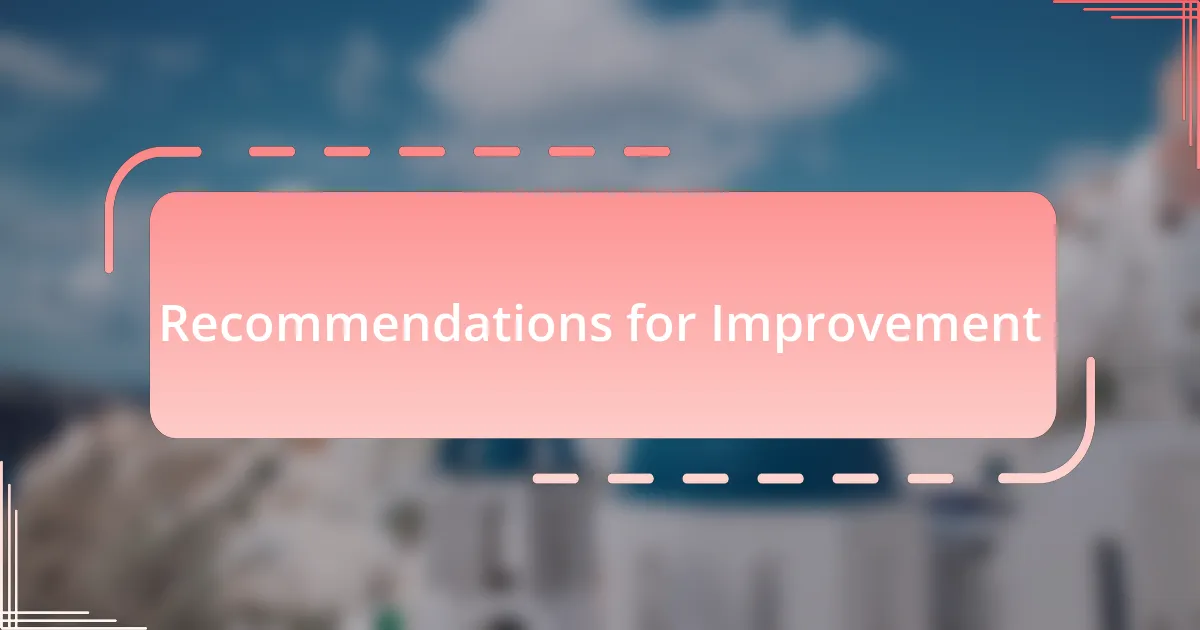
Recommendations for Improvement
One of my key recommendations for improving curriculum effectiveness is to incorporate more interactive activities that resonate with students’ lives. For instance, I once organized a community service project that tied into our lessons on compassion and charity. The students thrived in that environment, as they could see the real-world application of their faith in action. This experience made me wonder: how many other curriculum elements could be transformed into hands-on experiences?
Another approach I advocate for is the use of diverse assessment methods that allow for a deeper understanding of student learning. I recall a time when I asked students to express their thoughts creatively—some chose art, others wrote poetry. This diversity not only validated their different learning styles but also brought forth powerful insights that traditional exams could never capture. Are we restricting creativity in our evaluations, thereby limiting our students’ potential to express their understanding fully?
Lastly, fostering a culture of continuous feedback is crucial. After introducing an anonymous suggestion box, I was astonished by the level of honesty in students’ feedback. It became clear that some felt intimidated by speaking up in class, yet the anonymity empowered them to share their thoughts. This experience underscored the importance of creating safe spaces for dialogue. How can we improve our teaching methods if we don’t understand the barriers our students face?